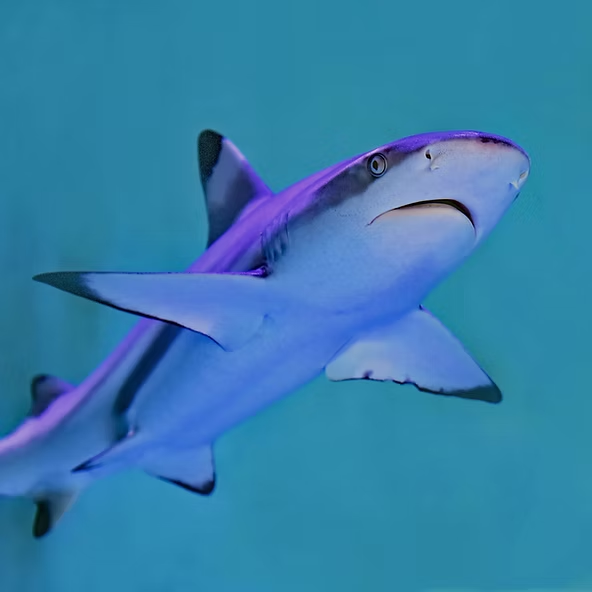Blacktip Shark: A Coastal Predator with Distinctive Fins
The blacktip shark is a widespread, medium-sized shark easily recognized by the dark markings on its pectoral, dorsal, and tail fins. These distinct black tips give the species its name. With their torpedo-shaped bodies and habit of leaping from the water while feeding, blacktip sharks are often mistaken for spinner sharks. Their agility and power make them a striking presence in tropical and subtropical seas worldwide.
Habitat and Distribution
Blacktip sharks prefer shallow coastal waters, including beaches, coral reefs, bays, and estuaries. They are a migratory species that often gather in small schools segregated by gender. On average, adults grow to about 5.5 feet (1.7 m) long and weigh around 55 pounds (25 kg), with females typically larger than males. The largest recorded female reached 6.8 feet (2.1 m) in length.
Reproduction and Life Cycle
Blacktip sharks reproduce through internal fertilization. Every two years, females give birth to 4–11 pups in shallow nursery areas, where the young are somewhat shielded from larger predators, including other sharks. These nurseries are critical to the survival of juvenile blacktips but are increasingly threatened by human activities such as coastal development and trawling.
Feeding and Behavior
These sharks primarily prey on bony fishes but also consume cephalopods, crustaceans, shrimp, and stingrays. Opportunistic hunters, blacktip sharks are frequently observed chasing after discarded bycatch near fishing vessels. Like all sharks, they possess electroreceptors in their snouts, which detect the faint electric signals emitted by potential prey. This adaptation allows them to hunt effectively even in murky waters.
Human Interaction
Blacktip sharks are one of the most commonly encountered shark species by swimmers, divers, and fishers along coastal waters. In the Gulf of Mexico, they are possibly the most abundant large shark species. However, their proximity to human activity makes them highly susceptible to accidental and intentional capture. They are a direct target for commercial fisheries, valued for their meat in American, Mexican, Indian, and Mediterranean markets, as well as for their fins in East Asian markets. Recreational fishers in U.S. and Mexican waters also prize them as a catch.
Conservation Concerns
Although relatively abundant, blacktip sharks are considered Near Threatened due to the pressures of overfishing and habitat loss. Juveniles are particularly at risk, as their shallow nursery grounds are vulnerable to boat traffic and destructive fishing methods such as bottom trawling. At present, there is no coordinated international management plan for blacktip shark fisheries. Without stronger protections, populations may decline significantly, reducing their important role as predators in coastal ecosystems.
A Species at the Crossroads
The blacktip shark embodies both resilience and vulnerability. Its wide distribution and adaptability have allowed it to thrive near human-dominated coastlines, yet those same qualities expose it to exploitation. Protecting nursery habitats and developing sustainable fishery regulations are crucial to ensuring that this swift, iconic predator continues to patrol the world’s coastal seas for generations to come.

